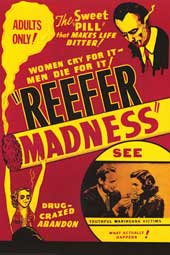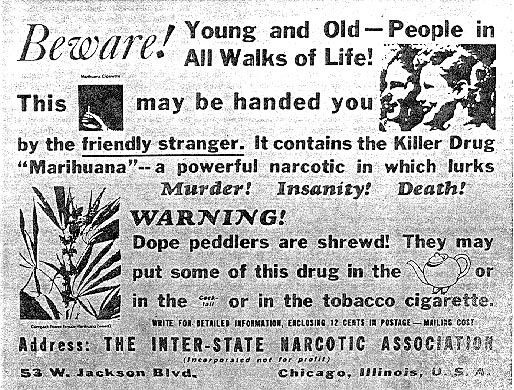Sociological Approaches to Drug-Related Deviance
Part 3. Macro-Relativistic Approach: Societal Definitions of Drug Problems
Media Definitions
of Deviance: Reefer Madness and the "Friendly Stranger"
The B-movie, Reefer Madness, contains some excellent examples of misleading, but apparently influential definitions of marijuana use as deviance that were promoted in the mass media during the 1930s. The movie is a morality tale of how "marijuana addiction" ruins the life of its young protagonist and gets a lot of other people killed, sexually compromised, and committed to lunatic asylums. In the black-and-white world of Reefer Madness, one puff of the Demon Weed instantly transforms the smoker into a horny, violent, cackling weed freak. It's a bad movie, but a gloriously bad movie -- thus the long-term appeal.
Reefer Madness began its cinematic life as a 1936 cautionary film entitled Tell Your Children. It was financed by a small, earnest church group, and was intended to scare the living bejeezus out of any parent who viewed it. Soon after the film was shot, however, it was purchased by the notorious exploitation film maestro Dwain Esper (Narcotic, Marihuana, Maniac), who took the liberty of cutting in salacious insert shots and slapping on the sexier title of Reefer Madness, before distributing it on the exploitation circuit. After a brief run, the film lay forgotten for several decades. There was no concept of "after market" in those days, especially for films that existed outside the confines of the studio system, and were therefore considered "forbidden fruit." For this reason, neither Esper nor the original filmmakers bothered to copyright the movie, and it eventually fell into the public domain.
Enter Keith Stroup, founder of NORML (Nation Organization for Reform of Marijuana Laws). In 1971, this enterprising gentleman up bought a print of Reefer Madness for $297, cleaned it up and started showing it at pro-pot festivals. It was gigantic hit. Distributing Reefer Madness to college campuses of the 1970s helped bankroll the burgeoning film company New Line Cinema, which is now a major player in the Hollywood film industry. Today, the film is a cult phenomenon dwarfed only by The Rocky Horror Picture Show.
Source: http://www.reefermadness.org/writers/authors.html
